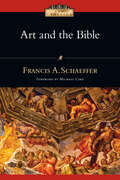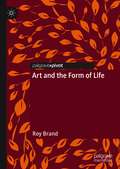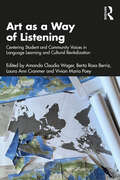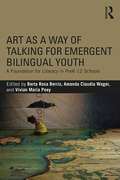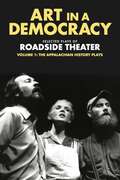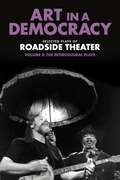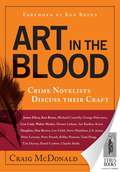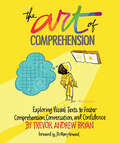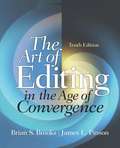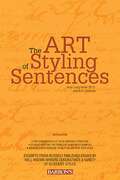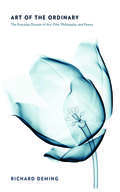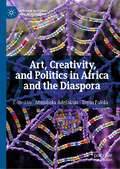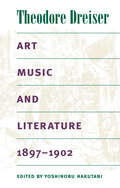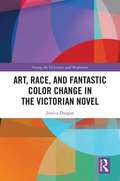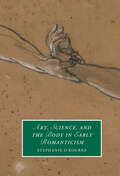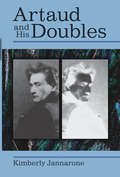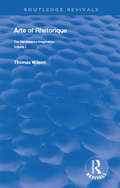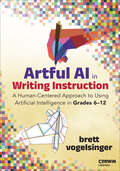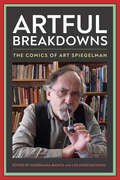- Table View
- List View
Art and the Bible: Two Essays (IVP Classics)
by Francis A. Schaeffer"The lordship of Christ should include an interest in the arts," writes Francis Schaeffer. "A Christian should use these arts to the glory of God, not just as tracts, mind you, but as things of beauty to the praise of God." Many Christians, wary of creating graven images, have steered clear of artistic creativity. But the Bible offers a robust affirmation of the arts. The human impulse to create reflects our being created in the image of a creator God. Art and the Bible has been a foundational work for generations of Christians in the arts. In this book's classic essays, Francis Schaeffer first examines the scriptural record of the use of various art forms, and then establishes a Christian perspective on art. With clarity and vigor, Schaeffer explains why "the Christian is the one whose imagination should fly beyond the stars."
Art and the Form of Life
by Roy BrandArt and the Form of Life takes a classic theme—philosophy as the art of living—and gives it a contemporary twist. The book examines a series of watershed moments in artistic practice alongside philosophers’ most enduring questions about the way we live. Coupling Tino Sehgal with Wittgenstein, cave art with Foucault, Stanley Kubrick with Nietzsche, and the Bauhaus with Walter Benjamin, the book animates the idea that life is literally ours to make. It reflects on universal themes that connect the long histories of art and philosophy, and it does so using a contemporary approach. Drawing on great philosophical works, it argues that life practiced as an art form affords an experience of meaning, in the sense that it is engaging, creative, and participatory. It thus effects a fundamental renewal of experience.
Art and the Religious Image in El Greco’s Italy
by Andrew R. CasperArt and the Religious Image in El Greco’s Italy is the first book-length examination of the early career of one of the early modern period’s most notoriously misunderstood figures. Born around 1541, Domenikos Theotokopoulos began his career as an icon painter on the island of Crete. He is best known, under the name “El Greco,” for the works he created while in Spain, paintings that have provoked both rapt admiration and scornful disapproval since his death in 1614. But the nearly ten years he spent in Venice and Rome, from 1567 to 1576, have remained underexplored until now. Andrew Casper’s examination of this period allows us to gain a proper understanding of El Greco’s entire career and reveals much about the tumultuous environment for religious painting after the Council of Trent.Art and the Religious Image in El Greco’s Italy is a new book in the Art History Publication Initiative (AHPI), a collaborative grant from the Andrew W. Mellon Foundation. Thanks to the AHPI grant, this book will be available in popular e-book formats.
Art and the Religious Image in El Greco’s Italy
by Andrew R. CasperArt and the Religious Image in El Greco’s Italy is the first book-length examination of the early career of one of the early modern period’s most notoriously misunderstood figures. Born around 1541, Domenikos Theotokopoulos began his career as an icon painter on the island of Crete. He is best known, under the name “El Greco,” for the works he created while in Spain, paintings that have provoked both rapt admiration and scornful disapproval since his death in 1614. But the nearly ten years he spent in Venice and Rome, from 1567 to 1576, have remained underexplored until now. Andrew Casper’s examination of this period allows us to gain a proper understanding of El Greco’s entire career and reveals much about the tumultuous environment for religious painting after the Council of Trent.Art and the Religious Image in El Greco’s Italy is a new book in the Art History Publication Initiative (AHPI), a collaborative grant from the Andrew W. Mellon Foundation. Thanks to the AHPI grant, this book will be available in popular e-book formats.
Art and the Transitional Object in Vernon Lee's Supernatural Tales
by Patricia PulhamIn her persuasively argued study, Patricia Pulham astutely combines psychoanalytic theory with socio-historical criticism to examine a selection of fantastic tales by the female aesthete and intellectual Vernon Lee (Violet Paget, 1856-1935). Lee's own definition of the supernatural in the preface to Hauntings questions the nature of the 'genuine ghost', and argues that this figure is not found in the Society of Psychical Research but in our own psyches, where it functions as a mediator between past and present. Using D.W. Winnicott's 'transitional object' theory, which maintains that adults transfer their childhood engagement with toys to art and cultural artifacts, Pulham argues that the prevalence of the past in Lee's tales signifies not only an historical but a psychic past. Thus the 'ghosts' that haunt Lee's supernatural fiction, as well as her aesthetic, psychological, and historical writings, held complex meanings for her that were fundamental to her intellectual development and allowed her to explore alternative identities that permit the expression of transgressive sexualities.
Art as a Way of Listening: Centering Student and Community Voices in Language Learning and Cultural Revitalization
by Berta Rosa Berriz Amanda Claudia Wager Vivian Maria Poey Laura Ann CranmerOffering a wealth of art-based practices, this volume invites readers to reimagine the joyful possibility and power of language and culture in language and literacy learning. Understanding art as a tool that can be used for decolonizing minds, the contributors explore new methods and strategies for supporting the language and literacy learning skills of multilingual students. Contributors are artists, educators, and researchers who bring together cutting-edge theory and practice to present a broad range of traditional and innovative art forms and media that spotlight the roles of artful resistance and multilingual activism. Featuring questions for reflection and curricular applications, chapters address theoretical issues and pedagogical strategies related to arts and language learning, including narrative inquiry, journaling, social media, oral storytelling, and advocacy projects. The innovative methods and strategies in this book demonstrate how arts-based, decolonizing practices are essential in fostering inclusive educational environments and supporting multilingual students’ cultural and linguistic repertoires. Transformative and engaging, this text is a key resource for educators, scholars, and researchers in literacy and language education.
Art as a Way of Talking for Emergent Bilingual Youth: A Foundation for Literacy in PreK-12 Schools
by Berta Rosa Berriz Amanda Claudia Wager Vivian Maria PoeyThis book features effective artistic practices to improve literacy and language skills for emergent bilinguals in PreK-12 schools. Including insights from key voices from the field, this book highlights how artistic practices can increase proficiency in emergent language learners and students with limited access to academic English. Challenging current prescriptions for teaching English to language learners, the arts-integrated framework in this book is grounded in a sense of student and teacher agency and offers key pedagogical tools to build upon students’ sociocultural knowledge and improve language competence and confidence. Offering rich and diverse examples of using the arts as a way of talking, this volume invites teacher educators, teachers, artists, and researchers to reconsider how to fully engage students in their own learning and best use the resources within their own multilingual educational settings and communities.
Art in a Democracy: Selected Plays of Roadside Theater, Volume 1: The Appalachian History Plays, 1975–1989
by Ben FinkSeminal plays and essays reveal the radical origins and approach of Appalachia’s Roadside TheaterThis two-volume anthology tells the story of Roadside Theater’s first 45 years and includes nine award-winning original play scripts; ten essays by authors from different disciplines and generations, which explore the plays’ social, economic, and political circumstances; and a critical recounting of the theater’s history from 1975 through 2020. The plays in Volume 1 offer a people’s history of the Appalachian coalfields, from the European incursion through the American War in Vietnam.
Art in a Democracy: Selected Plays of Roadside Theater, Volume 2: The Intercultural Plays, 1990–2020
by Ben FinkCollaborative plays with diverse ensembles across the country address pressing issues of our timesThe plays in Volume 2 come from Roadside’s intercultural and issue-specific theater work, including long-term collaborations with the African American Junebug Productions in New Orleans and the Puerto Rican Pregones Theater in the South Bronx, as well as with residents on both sides of the walls of recently-built prisons. Roadside has spent 45 years searching for what art in a democracy might look like. The anthology raises questions such as, What are common principles and common barriers to achieving democracy across disciplines, and how can the disciplines unite in common democratic cause?
Art in the Blood
by Craig McdonaldJames Ellroy, Dan Brown, Ian Rankin, George Pelacanoes, Ken Bruen, Michael Connelly, Ridley Pearson . . . the roster of writers interviewed in these pages includes those who have won Edgar, Shamus, Anthony and Macavity awards. The interviews were conducted in person, or by phone, or both. Significantly, none of the interviews were placed before the authors for approval, massaging or tweaking of answers. The interviews were recorded on tape and are presented without rejuxtaposition or revision on the part of the novelists. This is how the writers spoke, what they said, casually, candidly and, more importantly, on the fly.
Art of Comprehension: Exploring Visual Texts to Foster Comprehension, Conversation, and Confidence
by Trevor A. BryanThe Art of Comprehension' [creates] an invisible thread that stretches across varied professional contexts to connect art, literacy, and all content areas. From the forward by Dr. Mary Howard ' The Art of Comprehension: Exploring Visual Texts to Foster Comprehension, Conversation, and Confidence, Trevor A. Bryan introduces his signature method for enhancing students' understanding and thinking about all textsboth written and visual. By using what he calls 'access lenses (such as faces, body language, sound/silence) you can prompt all your students to became active explorers and meaning-makers. Organically and spontaneously, your classroom will become more student-centered.' ' Discover inventive ways to prompt students to notice, think about, and synthesize visualsusing the same observation and comprehension skills they can bring to reading and writing Learn about ways to unravel layers of meaning in picture books, chapter books, artwork, poetry, and informational text Explore the book's eclectic collection of art and illustration, by acclaimed illustrator Peter H. Reynolds, 19th century masters, and more. Bryan's approach allows all students to engage meaningfully with texts and join the classroom conversation.' With this comes the greatest reward of all: confidence and independence for all kinds of learners.
Art of Editing, The (Subscription)
by Brian S. Brooks L. Pinson JamesThe Art of Editing continues to be the standard by which editing texts are judged, offering the most comprehensive and up-to-date discussion of editing available. Long viewed as the "classic" in the field of editing, The Art of Editing continues to evolve to meet the needs of today's students. In addition to a focus on traditional newspaper editing, the authors pay significant attention to the other areas in which students are increasingly finding jobs: online media, corporate magazines, broadcasting, public relations and advertising. The ninth edition of The Art of Editing details the major changes revolutionizing the media industry and prepares students to work in convergent environments, where skill in print, broadcast and online operations is essential.
Art of Styling Sentences: 20 Patterns For Success
by Ann Longknife K. D. SullivanA Simon & Schuster eBook. Simon & Schuster has a great book for every reader.
Art of the Ordinary: The Everyday Domain of Art, Film, Philosophy, and Poetry
by Richard DemingCutting across literature, film, art, and philosophy, Art of the Ordinary is a trailblazing, cross-disciplinary engagement with the ordinary and the everyday. Because, writes Richard Deming, the ordinary is always at hand, it is, in fact, too familiar for us to perceive it and become fully aware of it. The ordinary he argues, is what most needs to be discovered and yet is something that can never be approached, since to do so is to immediately change it.Art of the Ordinary explores how philosophical questions can be revealed in surprising places—as in a stand-up comic’s routine, for instance, or a Brillo box, or a Hollywood movie. From negotiations with the primary materials of culture and community, ways of reading "self" and "other" are made available, deepening one’s ability to respond to ethical, social, and political dilemmas. Deming picks out key figures, such as the philosophers Stanley Cavell, Arthur Danto, and Richard Wollheim; poet John Ashbery; artist Andy Warhol; and comedian Steven Wright, to showcase the foundational concepts of language, ethics, and society. Deming interrogates how acts of the imagination by these people, and others, become the means for transforming the alienated ordinary into a presence of the everyday that constantly and continually creates opportunities of investment in its calls on interpretive faculties.In Art of the Ordinary, Deming brings together the arts, philosophy, and psychology in new and compelling ways so as to offer generative, provocative insights into how we think and represent the world to others as well as to ourselves.
Art, Creativity, and Politics in Africa and the Diaspora (African Histories and Modernities)
by Toyin Falola Abimbola AdelakunThis book explores the politics of artistic creativity, examining how black artists in Africa and the diaspora create art as a procedure of self-making. Essays cross continents to uncover the efflorescence of black culture in national and global contexts and in literature, film, performance, music, and visual art. Contributors place the concerns of black artists and their works within national and transnational conversations on anti-black racism, xenophobia, ethnocentrism, migration, resettlement, resistance, and transnational feminisms. Does art by the subaltern fulfill the liberatory potential that critics have ascribed to it? What other possibilities does political art offer? Together, these essays sort through the aesthetics of daily life to build a thesis that reflects the desire of black artists and cultures to remake themselves and their world.
Art, Music, and Literature, 1897-1902
by Theodore DreiserDreiser's captivating portraits of turn-of-the-century America's famous figures In this volume, liberally seasoned with period illustrations, Yoshinobu Hakutani has collected and annotated a rich selection of Theodore Dreiser's pre-fame writings on the cultural milieu of his day. In these brief essays, Dreiser sallies into the vibrant world of creative work in turn-of-the-century America. He inspects the eccentric and revealing paraphernalia of artists' studios, probes the work habits of writers, and goes behind the scenes in the popular song-writing business, where this week's celebrity is next week's has-been. He profiles famous figures and introduces numerous women artists, novelists, and musicians, including the prolific and tireless Amelia Barr (mother of fourteen children and author of thirty-two novels), the illustrator Alice B. Stephens, and the opera singer Lillian Nordica. Hakutani's notes provide biographical detail on dozens of now-obscure individuals mentioned by Dreiser.
Art, Race, and Fantastic Color Change in the Victorian Novel (Among the Victorians and Modernists)
by Jessica DurganAs a study of color in the Victorian novel, this volume notices and analyzes a peculiar literary phenomenon in which Victorian authors who were also trained as artists dream up fantastically colored characters for their fiction. These strange and eccentric characters include the purple madwoman Bertha Mason in Charlotte Brontë’s Jane Eyre (1847), the blue gentleman Oscar Dubourg from Wilkie Collins’s Poor Miss Finch (1872), the red peddler Diggory Venn in Thomas Hardy’s The Return of the Native (1878), and the little yellow girls of Arthur Conan Doyle’s "The Yellow Face" (1893) and Frances Hodgson Burnett’s The Secret Garden (1911). While color has been historically viewed as suspicious and seductive in Western culture, the Victorian period constitutes a significant moment in the history of color: the rapid development of new color technologies and the upheavals of the first avant-garde art movements result in an increase in coloring’s prestige in the art academies. At the same time, race science appropriates color, using it as a criterion for classification in the establishment of global racial hierarchies. These artist-authors draw on color’s traditional association with constructions of otherness to consider questions of identity and difference through the imaginative possibilities of color.
Art, Science, and the Body in Early Romanticism (Cambridge Studies in Romanticism)
by Stephanie O'RourkeCan we really trust the things our bodies tell us about the world? This work reveals how deeply intertwined cultural practices of art and science questioned the authority of the human body in the late eighteenth and early nineteenth centuries. Focusing on Henry Fuseli, Anne-Louis Girodet and Philippe de Loutherbourg, it argues that romantic artworks participated in a widespread crisis concerning the body as a source of reliable scientific knowledge. Rarely discussed sources and new archival material illuminate how artists drew upon contemporary sciences and inverted them, undermining their founding empiricist principles. The result is an alternative history of romantic visual culture that is deeply embroiled in controversies around electricity, mesmerism, physiognomy and other popular sciences. This volume reorients conventional accounts of romanticism and some of its most important artworks, while also putting forward a new model for the kinds of questions that we can ask about them.
Artaud and His Doubles
by Kimberly JannaroneArtaud and His Doublesis a radical re-thinking of one of the most influential theater figures of the twentieth century. Placing Artaud's writing within the specific context of European political, theatrical, and intellectual history, the book reveals Artaud's affinities with a disturbing array of anti-intellectual and reactionary writers and artists whose ranks swelled catastrophically between the wars in Western Europe. Kimberly Jannarone shows that Artaud's work reveals two sets of doubles: one, a body of peculiarly persistent received interpretations from the American experimental theater and French post-structuralist readings of the 1960s; and, two, a darker set of doubles—those of Artaud's contemporaries who, in the tumultuous, alienated, and pessimistic atmosphere enveloping much of Europe after World War I, denounced the degradation of civilization, yearned for cosmic purification, and called for an ecstatic loss of the self. Artaud and His Doubleswill generate provocative new discussions about Artaud and fundamentally challenge the way we look at his work and ideas.
Arte of Rhethorique (Routledge Revivals)
by Thomas WilsonOriginally published in 1982, this book includes The Arte of Rhetorique by Thomoas Wilson, alongisde a critical analysis by Thomoas J. Derrick. It includes chapters on biographical context, a critical introduction, and historical collation.
Artful
by Ali Smith"A stimulating combination of literary criticism, essay, and fiction" (The New Yorker) from the incomparable Ali Smith Artful is a celebration of literature's worth in and to the world--it is about the things art can do, the things art is made of, and the quicksilver nature of all artfulness. A magical hybrid that refuses to be tied down to either fiction or the essay form, Artful is narrated by a character who is haunted--literally--by a former lover, the writer of a series of lectures about art and literature. Ali Smith's heady powers as a novelist and short story writer harmonize with her keen perceptions as a reader and critic to form a living thing that reminds us that life and art are never separate.
Artful
by Ali SmithAli Smith melds the tale and the essay into a magical hybrid form, a song of praise to the power of stories in our livesIn February 2012, the novelist Ali Smith delivered the Weidenfeld lectures on European comparative literature at St. Anne&’s College, Oxford. Her lectures took the shape of this set of discursive stories. Refusing to be tied down to either fiction or the essay form, Artful is narrated by a character who is haunted—literally—by a former lover, the writer of a series of lectures about art and literature. A hypnotic dialogue unfolds, a duet between and a meditation on art and storytelling, a book about love, grief, memory, and revitalization. Smith&’s heady powers as a fiction writer harmonize with her keen perceptions as a reader and critic to form a living thing that reminds us that life and art are never separate. Artful is a book about the things art can do, the things art is full of, and the quicksilver nature of all artfulness. It glances off artists and writers from Michelangelo through Dickens, then all the way past postmodernity, exploring every form, from ancient cave painting to 1960s cinema musicals. This kaleidoscope opens up new, inventive, elastic insights—on the relation of aesthetic form to the human mind, the ways we build our minds from stories, the bridges art builds between us. Artful is a celebration of literature&’s worth in and to the world and a meaningful contribution to that worth in itself. There has never been a book quite like it.
Artful AI in Writing Instruction: A Human-Centered Approach to Using Artificial Intelligence in Grades 6–12
by Brett VogelsingerDiscover strategies to use AI thoughtfully in every stage of the writing process—without compromising creativity or critical thinking Feeling conflicted about integrating artificial intelligence (AI) into your writing instruction? You’re not alone. In a world where AI-generated text can seem like a writing teacher’s enemy, incorporating it into writing instruction may feel like an act of betrayal. The advent of generative AI might feel like "one more thing" eroding students’ capacity for deep thinking. Artful AI in Writing Instruction offers strategies and lessons for middle and high school teachers to harness AI in a positive way, integrating it into the writing process and evaluating the ethics of its usage. Written by a full-time high school teacher, Brett Vogelsinger, the book focuses on evergreen principles and ideas rather than specific AI tools, providing concrete steps and lessons that teachers can implement without being technology experts. Acknowledging the varying perspectives of teachers on AI in writing instruction, from skepticism to enthusiasm, Brett offers a human-centered, considered, and ethical approach to using generative AI in the classroom. Demonstrating how AI can be used artfully in the classroom to enhance students′ writing skills and foster reflection on the writing process, this book Provides standards-aligned lessons that detail how AI can support instruction and assist students at each step of the writing process from prewriting through publishing Emphasizes how to use AI tools to mine authentic human ideas and enhance creativity in the classroom Aims to help teachers build a healthy relationship with AI technology and use it thoughtfully in their writing instruction Includes chapter features such as quotes from esteemed writers, real teacher and student voices, cautionary notes, and "Bot Thoughts" entries of example AI output Artful AI in Writing Instruction is a book that explores technology with humility, critiquing its drawbacks and harnessing its strengths, in an effort to guide teachers on how to use AI to help students grow their thinking and their skills rather than bypassing that development.
Artful AI in Writing Instruction: A Human-Centered Approach to Using Artificial Intelligence in Grades 6–12
by Brett VogelsingerDiscover strategies to use AI thoughtfully in every stage of the writing process—without compromising creativity or critical thinking Feeling conflicted about integrating artificial intelligence (AI) into your writing instruction? You’re not alone. In a world where AI-generated text can seem like a writing teacher’s enemy, incorporating it into writing instruction may feel like an act of betrayal. The advent of generative AI might feel like "one more thing" eroding students’ capacity for deep thinking. Artful AI in Writing Instruction offers strategies and lessons for middle and high school teachers to harness AI in a positive way, integrating it into the writing process and evaluating the ethics of its usage. Written by a full-time high school teacher, Brett Vogelsinger, the book focuses on evergreen principles and ideas rather than specific AI tools, providing concrete steps and lessons that teachers can implement without being technology experts. Acknowledging the varying perspectives of teachers on AI in writing instruction, from skepticism to enthusiasm, Brett offers a human-centered, considered, and ethical approach to using generative AI in the classroom. Demonstrating how AI can be used artfully in the classroom to enhance students′ writing skills and foster reflection on the writing process, this book Provides standards-aligned lessons that detail how AI can support instruction and assist students at each step of the writing process from prewriting through publishing Emphasizes how to use AI tools to mine authentic human ideas and enhance creativity in the classroom Aims to help teachers build a healthy relationship with AI technology and use it thoughtfully in their writing instruction Includes chapter features such as quotes from esteemed writers, real teacher and student voices, cautionary notes, and "Bot Thoughts" entries of example AI output Artful AI in Writing Instruction is a book that explores technology with humility, critiquing its drawbacks and harnessing its strengths, in an effort to guide teachers on how to use AI to help students grow their thinking and their skills rather than bypassing that development.
Artful Breakdowns: The Comics of Art Spiegelman (Tom Inge Series on Comics Artists)
by Georgiana Banita and Lee KonstantinouContributions by Georgiana Banita, Colin Beineke, Harriet Earle, Ariela Freedman, Liza Futerman, Shawn Gilmore, Sarah Hamblin, Cara Koehler, Lee Konstantinou, Patrick Lawrence, Philip Smith, and Kent Worcester A carefully curated, wide-ranging edited volume tracing Art Spiegelman’s exceptional trajectory from underground rebellion to mainstream success, Artful Breakdowns: The Comics of Art Spiegelman reveals his key role in the rise of comics as an art form and of the cartoonist as artist. The collection grapples with Spiegelman’s astonishing versatility, from his irreverent underground strips, influential avant-garde magazine RAW, the expressionist style of the comics classic Maus, the illustrations to the Jazz Age poem “The Wild Party,” and his response to the September 11 terrorist attacks to his iconic cover art for the New Yorker, his children’s books, and various cross-media collaborations. The twelve chapters cut across Spiegelman’s career to document continuities and ruptures that the intense focus on Maus has obscured, yielding an array of original readings. Spiegelman’s predilection for collage, improvisation, and the potent protest of silence shows his allegiance to modernist art. His cultural critique and anticapitalist, antimilitary positions shed light on his vocal public persona, while his deft intertextual strategies of mixing media archives, from comics to photography and film, amplify the poignance of his works. Developing new approaches to Spiegelman’s comics—such as the publication history of Maus, the history of immigration and xenophobia, and the cartoonist’s elevation of children’s comics—the collection leaves no doubt that despite the accolades his accessible comics have garnered, we have yet to grasp the full range of Spiegelman’s achievements in the realm of comics and beyond.
